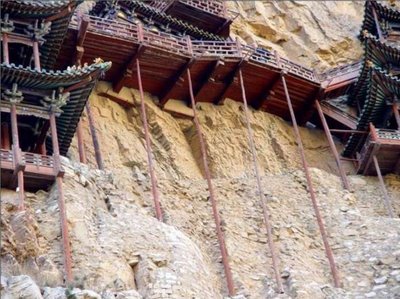Hanging Monastery

Wednesday, August 09, 2006
The monastery dates back over 1400 years to the Northern Wei Dynasty. However, most of what you see today are reconstructions made during the Ming (1368-1644) and Qing (1644-1911) Dynasties.

The caves behind the pavilions contain religious statues. One cave room has the statues of Buddha, Confucius and Laotsu comfortably sitting side by side. This is noteworthy because simultaneously advocating Buddhism, Confucianism and Taoism was rare in ancient China.

The pavilions are constructed almost entirely of wood (except for the decorative multi-hued roof tiles).

The pavilions "hang" partially because long timber poles support them from underneath (see photo). However, the greatest structural support comes from unseen rock ledges upon which parts of the pavilions sit - and from the cantilevered wooden beams deeply imbedded into the cliff.
The Chinese name of the Hanging Monastery is Xuankong.

The monastery is also known as the Hengshan Hanging Monastery. It gets its "Hengshan" descriptive because it is located at the foot of Mount Heng (Hengshan), one of the five holy Taoist mountains of China.

Location:The Hanging Monastery is in Shanxi province - and is about 80 kilometers (50 miles) south of Datong city, which is about 300 kilometers (180 miles) west of Beijing.

The caves behind the pavilions contain religious statues. One cave room has the statues of Buddha, Confucius and Laotsu comfortably sitting side by side. This is noteworthy because simultaneously advocating Buddhism, Confucianism and Taoism was rare in ancient China.

The pavilions are constructed almost entirely of wood (except for the decorative multi-hued roof tiles).

The pavilions "hang" partially because long timber poles support them from underneath (see photo). However, the greatest structural support comes from unseen rock ledges upon which parts of the pavilions sit - and from the cantilevered wooden beams deeply imbedded into the cliff.
The Chinese name of the Hanging Monastery is Xuankong.

The monastery is also known as the Hengshan Hanging Monastery. It gets its "Hengshan" descriptive because it is located at the foot of Mount Heng (Hengshan), one of the five holy Taoist mountains of China.

Location:The Hanging Monastery is in Shanxi province - and is about 80 kilometers (50 miles) south of Datong city, which is about 300 kilometers (180 miles) west of Beijing.








1 Comments:
on my list of places to see before I die
Post a Comment
<< Home